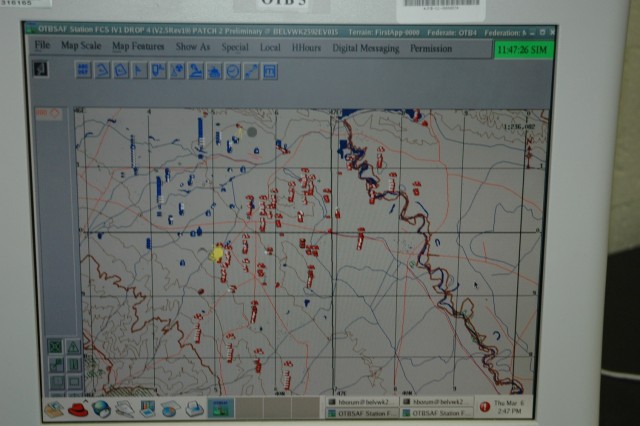FORT BELVOIR, Va. - The U.S. Army Research, Development and Engineering Command won this year's Army Modeling and Simulation Award for the MATREX and their work in the Operational Test Command Analytical Simulation and Instrumentation Suite. The award was presented March 11 by James Cooke, director, Army Modeling and Simulation, at the Department of Defense Modeling and Simulation Conference in Orlando, Fla.
MATREX, Modeling Architecture for Technology, Research and Experimentation, was integrated with the stand alone simulation environment at OTC in an effort to establish OASIS.
RDECOM's efforts saved OTC hundreds of thousands in development funds; accelerated OTC's federation roll-out date by at least 18 months; and has had a profound impact on the Army's most critical systems development and fielding effort -- the Future Combat Systems.
The MATREX products will allow OTC engineers to have a place to integrate technologies and troubleshoot problems with equipment prior to the production process. It simulates multiple platforms at the entity level in the tactical combat environment, allowing engineers to monitor how the platforms and equipment work with each other in the Future Force.
The system provides data for the analyses used to create a 'Blended Force' by combining data from currently deployed equipment with the new and improved technologies in FCS, in order to produce spin-outs of the new technologies for the Current Force to use.
"With this technology, Army experts have pertinent data to support analyses and decisions on products in the FCS, and other, platforms," said Tom Hurt, MATREX program manager. He explained that MATREX allows decision makers to simulate a proposed technology in a modeling and simulation environment to collect data for analyses that can help determine whether a new technology is beneficial to Soldiers in a combat environment. Then, the concept can be refined early in the acquisition process to better meet the need.
Collaboration is a key element to the success of the MATREX program, said Hurt. "Our Distributed Virtual Laboratory connects the modeling and simulation efforts across RDECOM, utilizes the team of systems engineers, and connects to the 3CE Network," said Hurt. This effort allows engineers and developers from across the country to share information about their work collaboratively , increase consistency, and better focus resources.
The MATREX program began in 2003. "The original intent was to provide a single M&S architecture for all the RDECOM elements," said Laura Pegher, former MATREX science and technology objective manager.
Today's MATREX employs a service-oriented architecture and composable environment designed to use plug-in technologies for compatability and interoperability among many different software applications. This becomes useful when a RDECOM element specializing in vehicle technology wants to combine efforts with a RDECOM element that specializes in communication and sensors.
With the MATREX, each piece of technology can be 'plugged-in' to the MATREX system and be translated so the technologies can speak to each other. These integrated technologies are referred to as federations. A federation is a collection of modeling and simulation tools that have been tested and integrated to work together.
The system provides a place to test a large number of simulations to interact with one another in once place. "With each release of a simulation, or federation, we can integrate and collect data from across the country and decrease the amount of time it takes to get to the right solution," said Howard Borum, MATREX integration and test engineer.
"This is the first exposure to the real world," said Borum. "This is the first place that a user can make a mistake, without costing money or lives on the battlefield." He said that in using this system the Army can, in a virtual environment, test new tactical procedures, equipment, and systems. This allows the Army to preview how a piece of equipment will perform in a tactical environment and help decision makers determine whether it would be beneficial to purchase the equipment.
"The idea is to bring technologies together in order to bring greater capabilities amongst the RDECOM elements," said Sidney Antommarchi, MATREX systems engineer lead.
Antonmmarchi said his team pictures what is needed in the battlefield through feedback from the field. "MATREX is able to come up with innovative solutions for problems the Army doesn't know about yet, while troubleshooting current issues in the field," said Antonmmarchi. He explained that the system is able to foresee potential issues, before the equipment is purchased and used in the field.
As they continue to collaborate with other organizations within and outside RDECOM,
the team looks forward to advancing the capabilities that MATREX offers. "We are committed to working with simulation components all over the Army," said Joseph McDonnell Ph.D., MATREX program principal scientist. "We are truly effective when we work jointly with other organizations."


Social Sharing